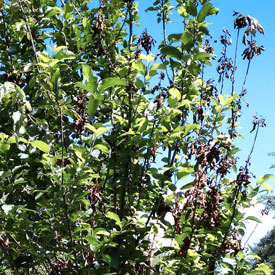

Symptoms include discolored spots on the surface of the fruit or leaf, which may eventually crack open, leading to premature dropping from the tree before harvest time arrives. Fire blight can be treated with antibiotics if caught early enough however it’s best avoided altogether by planting resistant cultivars of apples like ‘Liberty’ or ‘Empire’, which are known for their resistance against this disease.Īpple scab is another common fungal disease that affects both leaves and fruits of susceptible varieties. It causes leaves and twigs on infected branches to turn black or brown suddenly, giving them an appearance similar to being burned by fire – hence its name.
#FIRE BLIGHT ON APPLE HOW TO#
Knowing how to identify and treat these diseases can help you keep your apple trees healthy and productive for years to come.įire blight is a bacterial disease that affects apples as well as other plants, such as pears and crabapples. Common apple tree diseases include fire blight, apple scab, cedar apple rust, powdery mildew, and several viruses. Place organic mulch around the bottom of fruit trees to keep any fungal spores from splashing up on your tree in heavy rains or when watering them.Need more info? The basics of apple tree diseasesĪpple trees are, unfortunately, vulnerable to several illnesses. Remove dead leaves and plant debris at the base of fruit trees.High nitrogen fertilizers encourage new lush growth that attracts fire blight bacteria.Control aphids and insects that spread fire blight on your trees.
#FIRE BLIGHT ON APPLE PROFESSIONAL#
Professional writers are always ready to provide plagiarism-free papaers and ready to meet any deadline. Get high quality writing assistance fast, find original site where you can pay to write a research paper. Spray the vinegar solution on the fruit tree again in two weeks to ensure the fire blight well treated. Next, step back from the tree and spray the vinegar solution from top to bottom until the leaves are dripping. Point the nozzle at your tree and depress the lever on the wand to spray the tree from bottom to top and underneath the leaves. Pump the handle on the top of the sprayer to pressurize the contents.ĥ. Shake the sprayer gently to mix the contents. Pour in 6 cups of water and then 4 cups of white vinegar.

Open a 1-gallon garden sprayer by turning the lid counter clockwise. Dispose of the branches in an area that is at least 100 feet away from the tree.Ĥ. Cut off all branches at least 12 inches below the last branch that is wilted and discolored. Dip the shears in the bleach solution after each cut so as not to spread the infection. Prune all branches with fire blight off with shears. Add one cup of bleach to the bowl and stir the contents with a spoon.ģ. Measure 4 cups of water and pour it into a large bowl. To treat Fire Blight, first put on gloves to protect your hands from the bleach.Ģ. Apple, crabapple (Malus species), and firethorns (Pyracantha species) also are frequently damaged.ġ. Pear (Pyrus species) and quince (Cydonia) are extremely susceptible to Fire Blight. Fire Blight is caused by the bacterium Erwinia amylovora and is a frequently common destructive disease of some fruit trees and related plants. points out an Evergreen Pear (Pyrus Kawakamii) infected with Fire Blight.


 0 kommentar(er)
0 kommentar(er)
